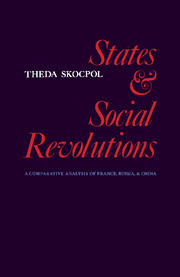Book contents
- Frontmatter
- Dedication
- Contents
- List of Tables and Maps
- Preface
- Introduction
- Part I Causes of Social Revolutions in France, Russia, amd China
- Part II Outcomes of Social Revolutions in France, Rusia, and China
- 4 What Changed and How: A Focus on State Building
- 5 The Birth of a “Modern State Edifice” in France
- 6 The Emergence of a Dictatorial Party-State in Russia
- 7 The Rise of a Mass-Mobiliang Party-State in China
- Conclusion
- Notes
- Bibliography
- Index
7 - The Rise of a Mass-Mobiliang Party-State in China
Published online by Cambridge University Press: 05 August 2014
- Frontmatter
- Dedication
- Contents
- List of Tables and Maps
- Preface
- Introduction
- Part I Causes of Social Revolutions in France, Russia, amd China
- Part II Outcomes of Social Revolutions in France, Rusia, and China
- 4 What Changed and How: A Focus on State Building
- 5 The Birth of a “Modern State Edifice” in France
- 6 The Emergence of a Dictatorial Party-State in Russia
- 7 The Rise of a Mass-Mobiliang Party-State in China
- Conclusion
- Notes
- Bibliography
- Index
Summary
Revolutions are profoundly influenced by the character of ruling classes. The entrenched localism of the gentry power made it inevitable that the Chinese revolution, in contrast to the revolutions of France and Russia, would come from the outlying areas to the center rather than the reverse …
Franz SchurmannLike the russian and the French Revolutions, the Chinese Revolution was launched by the breakdown of an autocratic and semibureaucratic Old Regime. And it culminated in a New Regime more centralized, mass-incorporating, and in many ways more fully rationalized and bureaucratic than the prerevolutionary Old Regime. In all three Revolutions, moreover, peasants provided the major insurrectionary force to transform old class relations. In France and Russia, social-revolutionary changes depended upon the occurrence of peasant revolts. Nevertheless, revolutionary state organizations were built up with the aid of primarily urban popular support and imposed through administrative hierarchies upon the rural areas. The postrevolutionary states in France and Russia both were (despite many differences) professional—bureaucratic regimes. In the Chinese Revolution, however, peasants ended up providing both the revolutionary insurrectionary force and the organized popular basis for the consolidation of revolutionary state power. And the result was a revolutionary New Regime uniquely devoted to fostering widespread participation and surprisingly resistant to routinized hierarchical domination by bureaucratic officials and professional experts.
- Type
- Chapter
- Information
- States and Social RevolutionsA Comparative Analysis of France, Russia and China, pp. 236 - 283Publisher: Cambridge University PressPrint publication year: 1979



